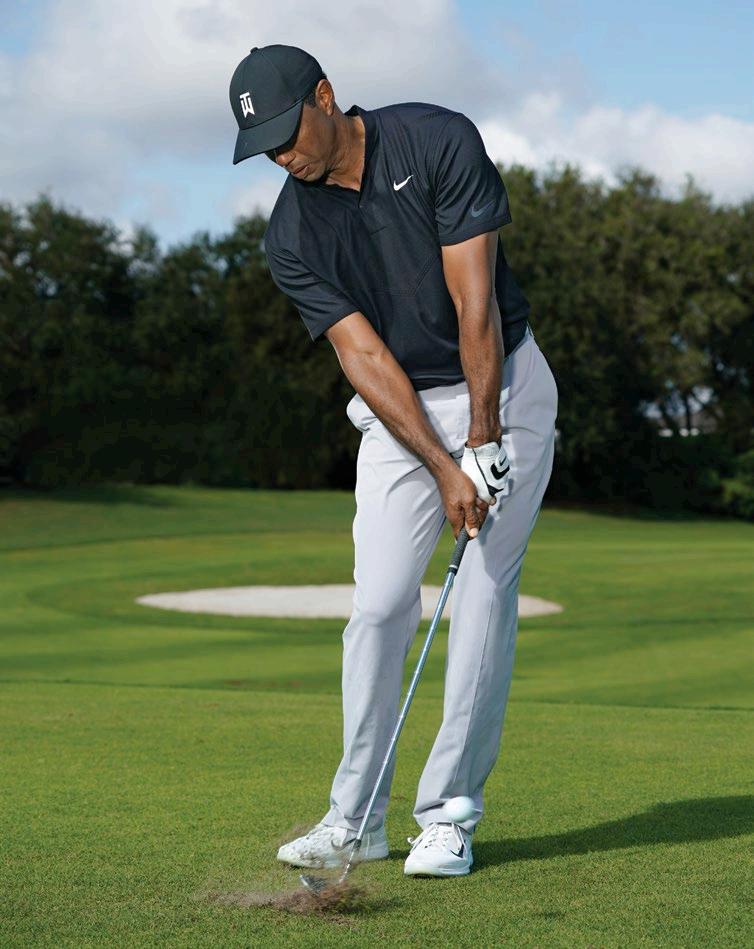
3 minute read
Chipping Clinic
Chipping Clinic Which technique is best? The one that produces solid contact
BY TIGER WOODS
the lowdown
▶ Read your chips like a putt
▶ Go with whatever produces good contact consistently
OME PLAYERS VIEW chipping and pitching as separate entities from the full swing. They have their full-swing feels, and they have their short-game feels. I’ve never thought of it that way. My short-game motion is a miniature version of my full swing—same grip, same rhythm, same release pattern. I like to have a continuous feeling in my hands through the bag, no matter if I’m sending a driver or nipping a short-sided spinner off a tight lie. It’s just easier for me to stay consistent that way.
That’s what it’s all about: Find the technique that gets you making solid contact most often, and stick with it unless, in rare cases, the situation forces you to do something different. You might think you have to mimic tour pros’ short games by learning a bunch of shots. There’s no need. When I went through my short-game woes a few years ago, to fi x it I got back to the basics and focused on simply making solid contact. You should do the same. If your chipping is poor, you’re wasting a ton of strokes.
Because my chipping motion is tied to my full swing, it has changed as I’ve worked with diff erent instructors over the years. At one point, I held the shaft more vertical and used a weaker grip. Then I switched up and my hands were lower at address than they are now. For me, getting comfortable with a new chipping motion has S





always been one of the hardest parts of a swing change, but it’s vital.
When chipping, my angle of attack is shallower than I’d recommend if you’re looking for more consistency. It’s probably easier to get good contact with a steeper motion, especially if you don’t have as much time to practice as I do. But being shallower is a big reason I can play so many diff erent short-game shots. Coming into the ball on a shallower path allows me to hit short shots with hook spin. Everyone can hit a cut-spin chip with a steeper angle of attack, but not many players feel comfortable shaping it the other way. But having that hook-spin chip as an option means I can let the golf course, not my limitations, dictate what shot I’m going to hit around the greens.
Although I recommend you stick to the chipping style that gives you the most confi dence, you still need to evaluate what you want the ball to do during your pre-shot routine. Take a few extra seconds to decide exactly where you want to land the ball, then visualise how it will perform once it’s on the green. I’ve seen amateurs get lazy and not read a chip like a putt and then seem surprised when it doesn’t snuggle up next to the pin. Be attentive. Once you’ve picked a specifi c landing spot, focus on contact. — WITH DANIEL RAPAPORT
MY WEDGES
▶ When I first came on tour, we all played balata balls that spun like hell. You really couldn’t chip with a 56- or 60-degree wedge very much, because if you nipped it, the ball would land and stop dead. Now balls spin less, and greens are typically faster than they used to be, so I use my TaylorMade Milled Grind 56- or 60-degree wedge on more than 90 percent of my chips (I don’t carry a gap wedge). And the grind on them allows me to create different shots. I have a pretty severe “C” grind, meaning there’s less bounce on the bottom of the club near the hosel and the toe than there is in the middle. This lets me lay the club flat when I want to hit a high, soft shot, or set the heel off the ground when I want to hit a low spinner.










